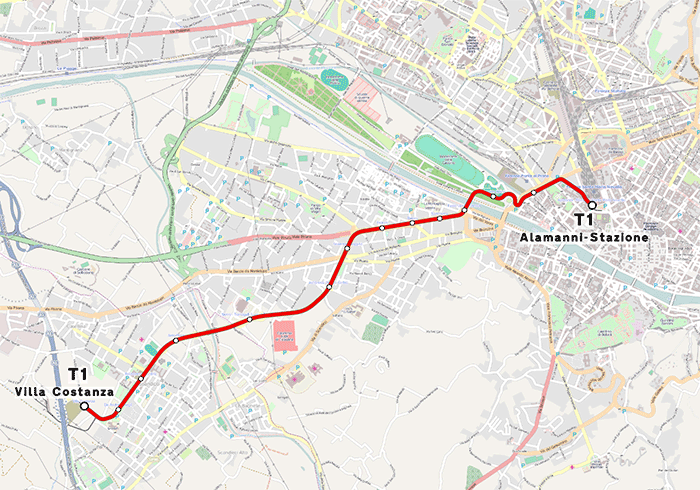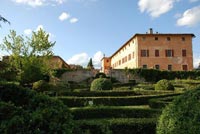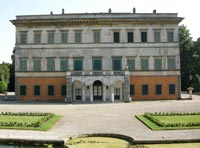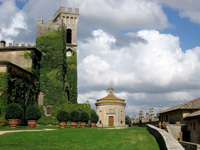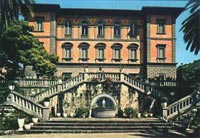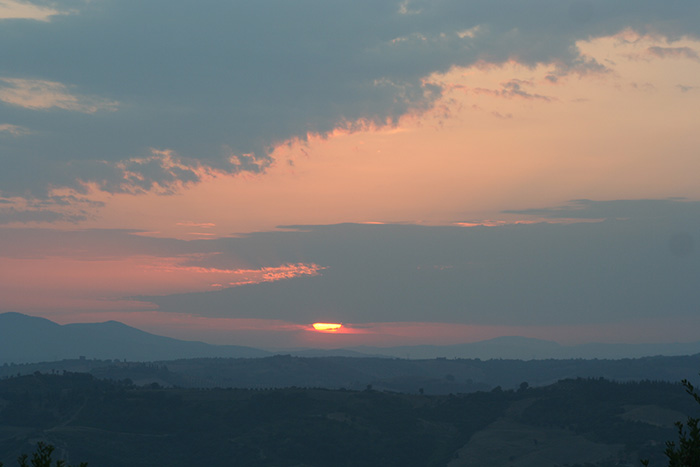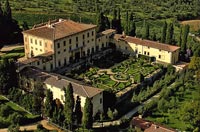
In fifteenth-century Florence, gardens became veritable places of the spirit, areas dedicated to meditation and philosophical speculation. Born as the ideal settings for the meetings for the neo-Platonic school of Marsilius Ficinus, gardens increasingly more acquired the features of a place of leisure and celebration of grand-ducal power as of the XVI century. These complex set designs of greenery and water were the fruit of a refined knowledge of architecture and hydraulics.
The theoretical foundations of the garden art were defined with the rediscovery of the classical world during the Age of Humanism. In the treatise De Re Aedificatoria, Leon Battista Alberti theorised the ideal of villa and garden: both had to translate the classical concept of otium, quiet life, a concept closely tied to the civil and cultural demands of the new merchant bourgeoisie. The garden was thus acknowledged a social purpose.
The attention of the major early-Renaissance writers of treatises fully introduced the garden art into the area of architecture. The garden was no longer the medieval hortus conclusus – an intimate area with geometric beds surrounded by walls, and in keeping with precise religious values. Thanks to a privileged relationship with the landscape, it acquired new and more modern possibilities for formal development.
The Early Medici Villas | The new sensitivity around garden design was immediately reflected in the villas that the Medici built or purchased in the vicinity of Florence. The Villa of Cafaggiolo was renovated by Michelozzo in 1451 on behalf of Cosimo the Elder. At the Villa of Careggi, also by Michelozzo, Lorenzo the Magnificent founded the Platonic Academy: it was in this villa’s garden that Marsilius Ficinus studied the therapeutic virtues of plants. The villa at Poggio a Caiano that Lorenzo the Magnificent purchased in 1479, was enlarged and renovated by Giuliano da Sangallo. Finally, at the villa of Fiesole, the Magnificent loved to immerge himself in poetic contemplation in the company of his guests.
City Gardens | The "villa garden" therefore translated an ideal of nature proper to Florentine Neo-Platonic culture, on one hand, and to the courtly patronage that found its highest expression in Lorenzo the Magnificent, on the other hand. A garden was also planted in the city, in the palazzo on the via Larga, built by Michelozzo by order of Cosimo the Elder de’ Medici, where the hedges were modelled into animal shapes; ancient sculptures and bas reliefs were instead assembled in a second courtyard. As Giorgio Vasari narrates, Lorenzo also wanted the garden of San Marco to be a museum of antiquities where artists could practise. The garden indeed hosted the greatest artists of the time: Sandro Botticelli, Filippino Lippi, Domenico Ghirlandaio, Leonardo, and Michelangelo who amazed the prince by sculpting a legendary faun’s head. In this refined cultural setting, dominated by the Neo-Platonic ideals, the garden was extolled by poets and painted by painters. In the late 15th century, all of Florence was a garden. Chroniclers reported many: in his Cronica Fiorentina, Benedetto Dei reports some 138 gardens.
The Age of Cosimo I | The duchy of Cosimo I dei Medici was a period of extraordinary vitality in every area of culture. Medici interest in the sciences was decisive for the development of the garden art. The impetus given to botanical studies by Cosimo I, responsible for instituting the Medicinal Herb Garden in 1545, was directly connected to the birth of the gardens of Florentine noblemen. Halfway through the century, the Serristori, Pandolfini and many other gardens were renowned for beauty and splendour.
Orto Botanico "Giardino dei Semplici" | The Botanical Garden of Florence, known as the "Giardino dei Semplici", was born as a garden of medicinal plants, and completed on December 1, 1545, under Cosimo I de’ Medici. It is the third oldest in the world. About two years before, Cosimo had founded the Botanical Garden of Pisa, the first example of a university Botanical Garden.
Palazzo Pandolfini Garden | The Built in the 15th century, the palazzo originally had a small flower garden and a large vegetable garden. According to Giorgio Vasari, the palazzo was remodelled on a project by Raffaello Sanzio around 1514 for bishop Giannozzo Pandolfini. The garden was embellished by statues, fountains, waterworks and numerous flower and plant varieties. This was an Italian garden, divided into two sectors. The largest, divided into four beds, had a small man-made hill, surrounded by flowers, citrus trees and a trammel-net of holm-oaks and laurel. The smaller sector facing the via San Gallo, instead, had a fountain in the middle, surrounded by geometric flower-beds and then by grapevines and fruit trees.
During the first half of the 19th century, Eleonora Pandolfini gave the garden an English layout and had a greenhouse built to shelter ornamental plants in winter. From 1870 to 1885, Alessio Pandolfini remodelled the palazzo, while his wife Sofronia Stibbert restored the original splendour to the garden, which became famous for its fine collections of camellias and cinerarias.
Palazzo Serristori Garden | For its unusual location close to a mill-race, parallel to the course of the Arno, Benedetto Varchi placed this garden among the ten most important gardens of Florence. Enlarged the first time during the first half of the 16th century, it was composed of a vegetable garden with geometrically shaped beds, separated by a lemon-house, and a lawn with a well, embellished by potted citrus trees, as also visible in the plan by Buonsignori. Towards the mid 17th century, a loggia was built that ended at the river, so as to create a closer relationship with the River Arno. Successively, the garden’s divisions were redesigned by engineer Antonio Ferri.
The garden received its most important modifications in the course of the 18th century. After knocking down the walls that closed the mill-race on the Arno, the garden was enlarged and placed in direct contact with the river. Between 1803 and 1806, a wide pensile promenade, on a project by Giuseppe Manetti, was built on the wall of the mill-race, which thus become a waterway inside the garden, contributing to increasing its space with the reflected images. The promenade in the direction of the Porta San Niccolò was embellished by aedicules, belvederes and rest areas. It concluded at a Kaffeehaus built on one of the gables of the Ponte alle Grazie (formerly Ponte Rubaconte).
Alfredo Serristori inherited the property in 1856 and transformed the garden into the English-style wood, still in part visible today. Following the works to make Florence capital, the Lungarno Serristori was built, which resulted in the garden’s drastic reduction, the destruction of the promenade and Kaffeehaus, and the construction in 1873 of a new facade along the Arno. The garden today is much smaller and poorly maintained, thus not allowing its full use by tourist flows.
Hanging Gardens | The preferred typology of suburban garden was the hanging garden, that is to say, a garden in complete symbiosis with a building. Among the first and most spectacular hanging gardens was the one built by Francesco I on the Loggia dei Lanzi, installed between 1583 and 1585, while Dominican friar Agostino Del Riccio also recalled the Acciaiuoli Garden: «Alessandro Acciaiuoli has begun to show how fine hanging gardens should be made, one on top of another, and so on to the top of the roof and all with good air, beds, fountains, espaliers and vases; and so these hanging gardens can be entered from several rooms of the house, offering great comfort to they who inhabit these houses and can go directly from the house into the garden».
One of the protagonists of the garden art in sixteenth-century Florence was Niccolò di Raffaello, known as Tribolo. His projects included the garden of the Villa at Castello, created around 1540 under commission to Cosimo I, so abundant in allegorical and symbolic references as to prove among the most significant examples of Renaissance gardens. Around the middle of the century, he also designed the Boboli Garden behind the palace of Luca Pitti, which Cosimo purchased as his new city residence and where, at his death, Tribolo was succeeded first by Luca Ammannati and then by Bernardo Buontalenti.
The Boboli Garden is one of the finest examples of Italian garden because, despite the transformations it underwent in time, it conserves its sixteenth-century architectural and scenographic layout. The project was by Niccolò Pericoli, known as Tribolo, instructed by Cosimo I de’ Medici in 1550 to create a garden for the Pitti Palace. Following the death of Tribolo, many architects succeeded one another in the course of the 16th century, in directing works in the garden, respecting the initial concept: Davide Fortini, Giorgio Vasari, Bartolomeo Ammannati and Bernardo Buontalenti.
Formerly the favourite residence of Cosimo de' Medici's mother, the Villa di Castello was renovated and decorated by Cosimo himself immediately after his election as the city's Grand Duke (1537). Impressive projects to enlarge the villa and landscape the gardens were promptly launched, in order to celebrate, through the various decorative elements, his astonishingly quick rise to power and his role as an ensurer of the peace and prosperity achieved. The garden, the best preserved specimen of an "Italian style garden", in accordance with Leon Battista Alberti's canons and descriptions, is organized along a central axis on three descending terraces, of which the first may be considered an external continuation of the Villa. A magnificent plumbing system supplied water to the numerous fountains. Among the decorative elements, stand-outs are the Fountain of Hercules and Antaeus, so called after the bronze group by Bartolomeo Ammannati, which decorates its top, and the Cave of the Animals or of the Flood, completed by Vasari, which celebrates, in a perfect simulation of a natural cave in which sculpture groups of animals in polychrome marbles are placed, the pacification of the living universe by Cosimo.
Address: Firenze, loc. Castello, Via di Castello 47
|
